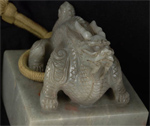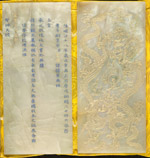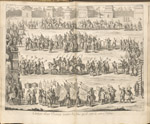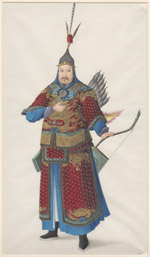Emblems and Mascots of Rulers:
Chinese Imperial Dragons
The dragon existed in China long before it became the symbol of the emperors; the dragon in the very famous shell mosaic of tomb M45, at the site Xishuipo in Henan province, is 6500 years old. As for the Imperial Dragon, its origin is not certain, but most scholars believe that it derived from the totems of different tribes. At the time of Confucius, the historiographer of the Duke Zhao of Lu in Shandong province wrote that the Emperors of the Golden Age used to breed dragons that drew their chariot across the sky. Already a royal symbol in Zhou and Qing times, the dragon became the emblem of the Han Dynasty. It was related to the cult of two early (and probably invented) Emperors, Huang Di and his brother Yan Di. At the end of his reign, the former was said to have been carried to the heavens by a yellow dragon, while Yan Di was allegedly born out of his mother’s telepathy with a dragon. The dragon with five claws appeared on the imperial robe, and everywhere in the Imperial palace. Today, many among the Han people consider Huang Di and Yan Di as their common ancestors, and refer to themselves as “the descendants of the Dragon.”
 |
Jade Seal. Beijing, presented to the Grand Temple in 1652. [zoom] This Jade Seal is inscribed with the four Han characters “Yuan Huang Hou Bao,” literally meaning “Treasure of the Original Empress” – plus the equivalent in the Manchu language. It was personally presented in 1652 by Emperor Shunzhi to the Grand Temple, in honor of the wife of an ancestor. A sitting dragon is carved on top of the seal. |
 |
Jade Book. Beijing, presented to the Grand Temple in 1674. [zoom] Jade books were used to celebrate the ascendance to the throne of new emperors; to record their sacrifices to Heaven and Earth; to bestow honorary titles on deceased emperors, empresses, and empress-dowagers; to celebrate the great achievements of the Emperor; and to “immortalize” his poems, essays, or solemn declarations. With the unification of China, they helped to affirm the continuity and solidity of the Qing Dynasty that ruled the huge empire from 1644 to 1912. The present book was compiled and inscribed, according to court regulations, to commemorate the recently deceased Shunzhi Emperor (1638-1661). An honorary title comprised of 19 characters was bestowed upon Him by his son, the new Emperor Kangxi (1661-1722), who presented this jade book to the Grand Temple, where the emperors of Ming and Qing Dynasties offered sacrifices to their ancestors. A silk book and a wooden book with the same content were also made; the silk book was burnt, while the wooden one was buried into the mausoleum. Only the jade book was preserved. This remarkable book consists of a series of ten jade tablets of greyish olive-green tone, each weighing approximately one pound. They are bound together with yellow silk straps; golden yellow is a color reserved for the Emperor. Tablets 2 through 4 are written in Chinese, while tablets 5 through 9 contain similar text in Manchu, the language of the Qing imperial court. The first and last tablets present identical designs: two five-clawed ascending and descending dragons between ruyi-shaped clouds in gold. The golden box is also decorated with dragons. |
 |
Jean-Baptiste du Halde, S.J. Description historique, chronologique, politique, et physique de l’Empire de la Chine et de la Tartarie chinoise, enrichie des cartes générales et particulières de ces pays, de la carte générale et des cartes particulières du Thibet, & de la Corée [etc]... La Haye: Scheurleer, 1736. [Facsimile] [zoom] Between the 16th and 18th centuries, Jesuits played a significant role in cultural exchanges between China and Western Europe. Although he had not visited China, Jean-Baptiste du Halde (1674-1743) collected seventeen missionary reports and wrote an encyclopedic survey of Chinese history, culture, and society. This detailed image of a procession shows a box (containing the seals of the chief minister) quite similar to the one made for Cornell’s jade book. |
 |
Watercolors. China, circa 1850. [zoom] | Additional images: 
Even though the accuracy of these refined watercolors -examples of the kind typically sold to Westerners in the port cities of China - is questionable, they confirm that while lords and mandarins were allowed to wear dragons with four claws or less on their clothing, only the Emperor (and sometimes members of the Imperial House) would usually wear five-clawed dragons. In 1736, Du Halde wrote about the Emperor: “His clothing is embroidered with dragons: they are his emblem, and only He can wear dragons with five claws - any infringement to this rule is punished severely.” |